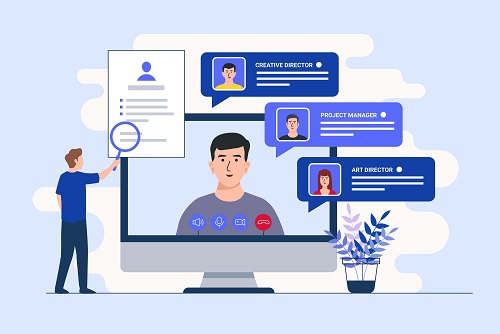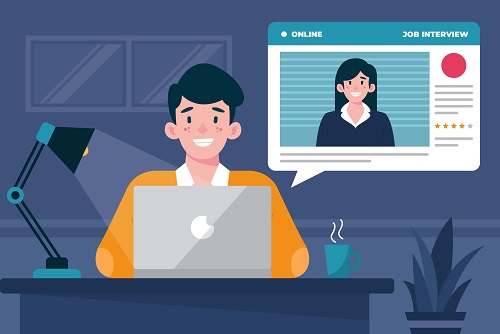When was the last time you worked in the office? Probably several months ago. The arrival of the global Covid-19 pandemic has changed the way we work and made working from home become the “new normal”. Turbulent times call for adaptive and digitized measures, and thus, conducting video interviews is the way to go to continue with your recruitment.
However, organizing video interviews is not as simple as making calls to your candidates or asking them to send several recorded videos. If video interviewing is emerging into your recruitment process or you have been a bit confused while dealing with it, great, this article is probably your go-to resource to set up your company’s video interview session.
What Are Video Interviews?
In general, there are two types of video interviews that every modern recruiter should consider while planning virtual recruiting.
- Two-way or live video interview: Recruiters conduct one-on-one or panel live interviews with candidates. These interviews are organized via free and easy-to-access platforms such as Skype, Hangouts, Zoom, or Microsoft Teams. Due to its interactive nature, this type of virtual interview can create engaging conversations for both parties. Along with these platforms, recruiters can also take a further step towards adopting new technology to optimize live video interviews. They can work with third-party vendors who provide advanced features such as games or quizzes to test candidates during interviews.
- One-way video interview or on-demand video interview: Interviewees receive predetermined questions and send recorded video to interviewers for further assessment. The two common practices of submitting these files are uploading to YouTube and sending the link to recruiters or recording and uploading videos to third-party recruiting platforms. Small projects and businesses often use the former as it’s free and convenient. However, it’s also hard to manage because videos are not centralized in one platform with supporting assessing tools such as integrated evaluation forms. Using open solutions also raises concerns about confidentiality and security among interviewees as accounts can be easily hacked, or a setting mistake may cause candidates’ videos to be published to unexpected audiences. Tech-savvy enterprises and organizations often use the latter solution with a big pool of candidates and certain budgets to invest in talent acquisition technologies.
How to Choose a Suitable Video Interview Format?
In general, video interviews can help you reduce costs and increase efficiency. Conducting video interviews can cut the cost of setting up meetings, traveling to different locations, and saving your precious time from switching between meetings or organizing proper logistics. It is also convenient as you can conduct multiple interviews from your working desk and expand your recruiting pool with remote talents.
In terms of optimization, different types of video interviews can fit into different stages.
The one-way video interview can be used in the early stage of your recruitment process when you have multiple candidates to screen. Using a self-recorded video process allows candidates to complete the recording at their own paces while modern recruiters can speed up the hiring process and manage your time effectively. Additionally, some innovative HR technology vendors have also introduced advanced features such as automated evaluation or AI-powered solutions to screen and evaluate a great number of candidates promptly. The latter option can analyze videos and rank candidates objectively based on their facial movements, word choices, etc.
Two-way video interviews are often scheduled later when star talents are shortlisted to save the valuable time of both parties before making decisions. Live video interviews also become necessary when the team is scattered and it’s better to have all stakeholders in one video conference.
💡Before you start scheduling, here are 10 critical mistakes to avoid when checking candidates’ availability for interview.

Source: This image is designed by Freepik
10 Best Tips When Setting up Your First Video Interview
01. Setting up the Process and Communicating Clearly
Adopting video interviews may result in several changes in your recruitment process. Thus, it is advisable to communicate clearly to both candidates and other team members and keep them updated.
02. Scheduling Properly
Scheduling interviews effectively is not as simple as making a phone call or sending an email, especially when you are having multiple candidates or are recruiting for remote positions. Don’t let the candidate’s experience be affected by mistakes like inadequate information and back-and-forth communication. Some minor flaws include forgetting to mention the interview platform or sending out wrong links to different meetings.
03. Using Accessible Platforms
Let’s keep it simple, convenient, and risk-free. Candidates are more likely to have a positive experience when recruiters use common interviewing platforms or anything that does not require downloading or filling in a long registration form. Using accessible platforms can also help both parties avoid unnecessary technical issues. Thus, it is advisable to communicate clearly to both candidates and other team members and keep them updated.
04. Giving a Technical Test Run Beforehand
You should check all possible technical problems before organizing and conducting interviews. Issues are varied based on your working environment, but a short suggested checklist for you includes wifi connection, webcam, microphone, and speaker.
05. Providing Materials and Appointing Contact Person
If it is an on-demand video interview, make sure that you will send clear guidelines and materials so that your candidates won’t feel lost when they start the interview on their own. Furthermore, as pre-recorded videos can be made anywhere at any time while technical problems may happen at odd times, recruiters should also include information on a contact point for technical support. It’s better to let candidates know that there is someone to ask for help.
06. Inviting the Candidate Early With Live Video Interview
If it is a two-way video interview, make sure that you invite interviewees at least 10 minutes early to perform technical testing to avoid any problems coming from either party.
07. Preparing a Clear Instruction
If you have a complex process or use a third-party platform, it’s advisable to include a guideline in your email for candidates to go over before starting the interview session. The instruction should include the interview process, features of the platform, and what candidates should know in order to avoid technical issues.
08. Setting a Professional Space
You can set up the interview space to give candidates a professional impression for a two-way video interview. Clearing scratch paper, arranging the fallen objects, or moving your tools to the proper place may help you create a clean, sleek, and distraction-free background for live interviews. This practice will also be worth notice if you plan to record question videos for on-demand video interviews.
09. Checking With Interviewers for Setting Up
If it is a two-way video interview, you should check with interviewers to know whether they would like some help to set up a room for video interviewing or they want to handle it on their own following your written instruction.
10. Asking for Feedback and Improving

As you are just implementing a new assessment method, make sure that you will prepare surveys for your candidates and interviewers to evaluate after the first video interview session. Many third-party solutions have this feedback form as a feature of the solution to allow you easily capture candidates and interviewers’ feedback. If there is anything wrong, let’s improve it next time.
Source: This image is designed by Freepik
3 Tips to Stay Attractive and Competitive
01. Having a Company Culture Pitch
It’s likely that you won’t be able to invite talents to the office and get them interested in your exciting working environment and culture in the near future. No worries. You can get them hooked and stand out from the crowd with a well-prepared, interesting company culture pitch during interviews. If your video interview platform allows uploading videos and/ or slideshows, you definitely should consider adding one of your company cultures. If the platform does not offer this feature, you should at least provide them to your emails to the candidates prior to their interviews.
02. Keeping It Engaging
Imagine that you are looking at your digitized version on the screen and talking to yourself. That’s the experience of candidates who are recording videos for one-way interviews. However, you can make it more interesting by having videos about the company and teams before and after the interview questions. Visuals and sounds are more appealing compared to plain text.
03. Use Advanced Technology for Efficiency
HR Technology is your great teammate in this digital era. Check out our article on virtual recruiting for more ideas.
Final Thoughts
In these uncertain, unprecedented times, adopting HR technologies and digitalizing the recruitment process are your go-to strategies to keep the business going. Don’t be afraid to test new methods or adopt new technologies into your process. Organizing your first video interview session or dealing with a surging number of virtual interviews may be a bit tricky, but we are here to help. Along with this article on 10 things to know when setting up interviews, check out our blog for more tips to rock virtual recruitment!


